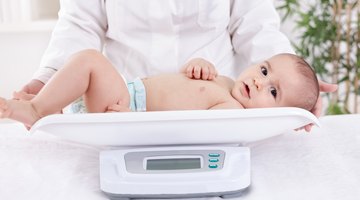Head Circumference vs. Chest Size
The relationship of the circumference of the head to the circumference of the chest in infants and children changes with age. These measurements are routinely taken by the pediatrician and can alert him or her to abnormalities in the brain or in overall body growth.
Normal Head and Chest Circumference
A newborn's head circumference, measured at the level of the baby's eyebrows, is between 32 and 36.8 centimeters -- 12.6 to 14.5 inches. It is approximately two to three centimeters larger than the chest circumference which, when measured at the nipple line, is between 30 and 33 centimeters -- twelve to thirteen inches. Between the ages of six months and two years, measurements of head circumference and chest circumference are equal. As the child gets older, chest circumference exceeds head circumference.(1,2)
Abnormal Head Circumference

Head Circumference for a 1-Year-Old
Learn More
When the head circumference is large and more than four centimeters greater than chest circumference, the infant's head is growing too fast. This indicates either an inherited or acquired disorder of the brain, or fluid accumulation around or within the brain -- hydrocephalus--. In families where there is a tendency towards a large head size -- benign familial macrocephaly -- a large head circumference may be normal. If head circumference is less than 32 centimeters, the brain is too small -- microcephaly. Microcephaly is associated with fetal infection, chromosomal disorders and congenital malformations.(1, 2)
Abnormal Chest Circumference
A small chest circumference and normal head circumference in a newborn baby, called asymmetric growth restriction, may be seen in babies whose mothers have high blood pressure or kidney disease (1). Since normal growth requires adequate nutrition, chest circumference is also useful in assessing malnutrition. It is recommended as a measure of poor nutrition by The World Health Organization. Chest circumference and has been shown be low not only in obviously malnourished children but also in children from lower socioeconomic groups.(4)
Ratio of Head and Chest Circumference

How to Measure Baby Length for a Growth Chart
Learn More
During growth, the rate of increase in head circumference is steady, while chest circumference grows faster. This results in equalization of the circumference of the head and chest in by age two. In malnutrition, the rate of brain growth is protected but the rate of chest growth slows. As a result, the expected equalization of the head and chest circumference is delayed and chest circumference remains less than head circumference. The ratio of head and chest circumference can be used as a rough guide to assess the amount of growth failure from malnutrition.(3)
Related Articles
- The Global Library of Women's Medicine:The Normal Neonate: Assessment of Early Physical Findings
- Delmar's Comprehensive Medical Assisting, Pediatrics; Wilburta Lindh, Marilyn Pooler, Carol Tamparo, Barbara Dahl
- Indian Medical Gazette: Comparative Study of Height, Weight and Chest Circumference among Children of Municipal Corporation School and Private School
- Lippincott's Nursing Procedures, Maternal Neonatal Care











